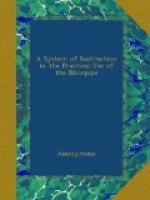When exposed to ignition with free access of air, all manganese oxides are converted into (MnO + Mn^{2}O^{3}), but without fusion. Such, at least, is the statement of some of the German chemists, although it will admit perhaps of further investigation.
Manganese oxides fuse with borax in the oxidation flame to a clear and intensely colored bead, of a violet hue while hot, but changing to red as it cools. If a considerable quantity of the oxide is added, the bead acquires a color so dark as to become opaque. If such be the case, we have to press it flat, by which its proper color will become manifest.
In the reduction flame the bead is colorless. A very dark colored bead must be fused upon charcoal with the addition of some tin. The bead must be cooled very suddenly, for if it cools too slowly, it then has time to oxidize again. This may be effected by pushing it off the platinum wire, or the charcoal, and pressing it flat with the forceps.
The oxides of manganese fuse with microcosmic salt in the oxidation flame, to a clear brownish-violet bead, which appears reddish-violet while cooling. This bead does not become opaque when overcharged with manganese. As long as it is kept in fusion a continued boiling or effervescence takes place, produced by the expulsion of oxygen, in consequence of the fact that the microcosmic salt cannot dissolve much sesquioxide, while the rest is reduced to protoxide, is re-oxidated, and instantly again reduced. If the manganese is present in such a minute quantity as not to perceptibly tinge the bead, the color may be made to appear by the contact of a crystal of nitre while hot. The bead foams up upon the addition of the nitre, and the foam appears, after cooling, of a rose-red or violet color. In the reduction flame the bead sometimes becomes colorless.
The oxides of manganese fuse with carbonate of soda upon platinum foil or wire, to a clear green bead, which appears bluish-green and partially opaque when cold (manganate of soda NaO + MnO^{3}). A very minute trace of manganese will produce this green color. The oxides of manganese cannot be reduced upon charcoal with carbonate of soda before the blowpipe. The soda is absorbed, and (MnO + Mn^{2}O^{3}) is left.
GROUP FIFTH.—IRON, COBALT, NICKEL.
The oxides of this group are reduced to the metallic state when fused with carbonate of soda upon charcoal in the reduction flame. Metals when thus reduced form powders, are not fusible or volatile in the blowpipe flame, but they are attracted by the magnet.
Furthermore, these oxides are not dissolved by carbonate of soda in the oxidation flame, but they produce colored beads with borax and microcosmic salt.
(a.) Iron.—It occurs in great abundance in nature. It is found in several places in America in the metallic state, and it likewise occurs in the same state in meteors. It occurs chiefly as the oxide (red hematite, brown hematite, magnetic oxide, etc.), and frequently in combination with sulphur. Iron also forms a constituent of the blood.




